Elephants and Bees
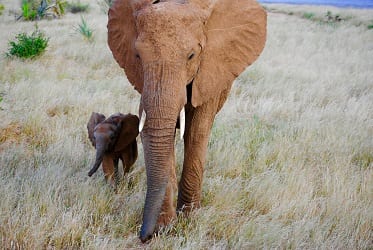
UCF Biology student Matthew Rudolph, 31, always knew he wanted a career that involved animals, but he never envisioned using tiny honeybees to help save the world’s largest land mammal. Still, that’s exactly what Rudolph has been doing for the past six months, working alongside a team of international researchers in Kenya to build fences with beehives.
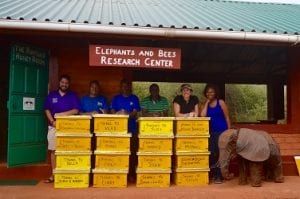
The special fences scare off elephants. And that fear may reduce injuries and deaths from human-elephant conflicts in the African nation.
Elephants are protected in Kenya, but they are migratory and that often leads to conflicts with local farmers. The animals tend to tear up small farms, which the farmers rely on for their livelihood. This leads to conflicts that sometimes result in injuries and deaths for people and elephants.
Scientists from the nonprofit organization Save The Elephants, under the direction of zoologist Lucy King, discovered that these giant beasts are afraid of bees. They established the “Elephants and Bees” project, by coming up with the ingenious fence design that embeds beehives within the wire fences about every 30 feet. When the elephants touch the fence, the hives shake and the bees start buzzing. As soon as the elephants hear the buzz, they start shaking their ears and blow their trunks to warn others and hightail it in the other direction.
“It’s pretty amazing,” Rudolph said. “It’s a great nondestructive solution to the human- wildlife conflict. I love being part of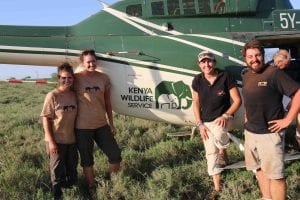 the solution and it helps keep one more animal on the planet for my future kids.”
the solution and it helps keep one more animal on the planet for my future kids.”
Rudolph is the project coordinator overseeing the camp’s daily operations. His job involves organizing a team of three or four international research interns, and three or four permanent staff members on the Elephants and Bees Project.
His days include tracking elephants through the bush for long-term monitoring, collecting data on the beehive fences, harvesting and producing elephant-friendly honey, building camera trap databases to identify individual animals, and supporting the local school through environmental education classes and implementing a one-acre permaculture display garden.
He’s also helped place collars on 10 elephants in the surrounding area to track their movements. This data will assist researchers in understanding the movement patterns over long durations. He’s also finding creative ways to keep honey badgers from raiding the beehives in the fences.
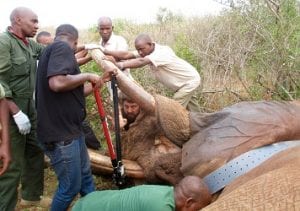
Rudolph said his involvement started with the realization that he had to do his part to help elephants before it was too late. He imagined reading a book with his future son. Then he imagined his son asking why he’d never seen the animal in the photograph and Rudolph stumbling for words to explain that people didn’t do enough to save the species from extinction.
“I thought about that for a minute and decided that I had to do something about it,” he said. “I knew I didn’t want to tell my kid that I didn’t do everything I could to save a species from extinction.”
Rudolph credits UCF biology professor John Weishampel with starting him on his adventure by showing him the power of geographical information systems also known as GIS. It is designed to capture, manipulate and analyze large amounts of varying data in a spatial way. Weishampel uses it in his own research to understand how landscape patterns influence ecological processes and biodiversity.
“He’s a great student,” Weishampel said. “He loves what he does. He has a great attitude.”
GIS is a powerful tool which many scientists are embracing. UCF is creating a cluster of experts from across disciplines to harness the power of the technology and impact several fields. For example, GIS can be used to help with crime mapping and to look at health-care disparities and even politics.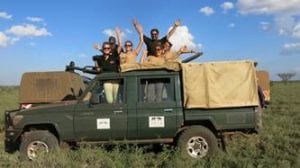
“People don’t recognize GIS, but a good example is The Weather Channel maps,” Weishampel said. “You can see clouds moving over areas of the country and even view information about your own neighborhood. That’s all thanks to combining GPS [Global Positioning System] and GIS technology.”
Students who learn how to use the technology are at an advantage.
“Matthew is using GIS to see connections with elephants and the environment,” Weishampel said. “It’s a pretty powerful tool that lets you see a lot of things with actual data.”
With this knowledge Rudolph began looking for a hands-on opportunity to help with conservation efforts and that could give him practical field experience. That led him to Save the Elephants’ doorstep and the Elephants and Bees Project.
Rudolph will return to UCF in May to complete his bachelor’s degree in biology. He’s looking to attend graduate school with a focus on conservation biology, so he can better prepare to work on his own projects in the future.
While he’s enjoyed his work in Africa, he is looking forward to returning home where his fiancé and their three-legged dog await. Pavlov, a rescue dog, was born with three paws and recently received his first prosthetic leg. Rudolph has missed home, but said he has learned so much.
 “It’s been such an amazing experience,” he said. “It’s a once-in-a-lifetime opportunity I couldn’t pass up.”
“It’s been such an amazing experience,” he said. “It’s a once-in-a-lifetime opportunity I couldn’t pass up.”
Get a behind the scenes look at Matthew’s African experience on his blog. Learn more about the Elephants and Bees Project here.
